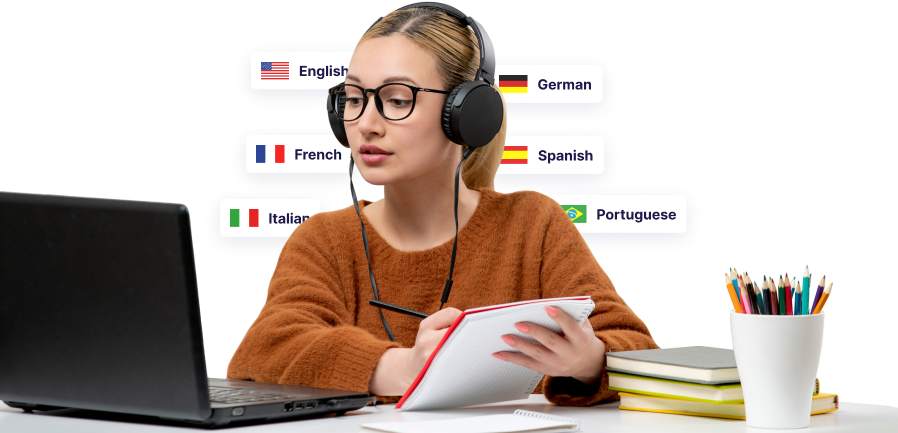Rapid Translate Team
Many are familiar with machine translation, although it’s risky to depend on it alone for formal processes. However, combining various translation tools and a professional human touch is all you need for success. Most people wonder how translation tools can improve productivity in communication.
These tools perform various functions that make the translation process faster. They also elevate the quality of translations with brilliant suggestions. You don’t need to worry about plagiarism, as quality assurance measures exist. But before using them, you must learn how they work.
So, read on to discover more about translation tools!

Table of Contents
What Is a Translation Tool?
A translation tool is any application program or software that enables translators to convert text into foreign languages. Generally, translation tools make work faster, easier, and seamless by applying technology or computing power.
With the aid of a transition tool, a job that would’ve taken a week can take a few days. If you consider it, that’s a whole lot of time saved. Beyond speeding up translation procedures, these tools also help to cut costs.
Normally, when translation agencies experience a surge in patronage, they often have to upgrade the number of staff. Though this is good as it shows growth and development, it comes with extra expenses.
So, to save money and get more value, translation agencies adopt machine translations and other similar tools. With a machine translation tool, one only needs to capture and input the source document for instant text translation.
Thus, it’s speedy, fast, and secure. After getting the initial draft, a professional human translator can review and edit the documents for accuracy and correctness. However, several other translation tools are available besides machine translations.
All translation tools share the common goal of improving the quality and speed of translations. Therefore, translation tools enable the expansion of global communication and interaction.
They promote the expansion of businesses into foreign markets and help individuals expand their reach. It is undebatable that human translators have the best capabilities. However, individuals can’t do everything on their own.
Therefore, translation agencies should leverage technology while recruiting the best available human resources. Any agency can attain great heights and reputation with skilled, experienced, trained translators and accurate translation tools.

4 Categories of Translation Tools
Different tools aid translation, and each performs a different function. People categorize these tools and software depending on their use and the technology behind their functionality.
Keep reading to learn about the top four prominent translation tool types available to enhance productivity.
1. Translation Management System (TMS)
A translation management system is software that manages the procedures and processes involved in translation on a large scale.
For example, document localization involves translating into different dialects and tailoring content to suit specific cultural backgrounds.
Localization takes a multilingual approach, making tracking and monitoring of translated documents difficult. A transition management system is a combination of tools that manage and monitor digital assets.
The word “manage” is broad and encompasses several aspects. Document management entails digital or electronic capturing through gadgets, some of which can convert document formats.
For instance, optical recognition tools can scan and convert images with legible text into word format. Management also includes storage modes through which translators save documents securely online.
Other essential parts of management are tracking, monitoring, and access control. Hence, translation management systems adhere to data security terms and regulatory compliance.
Translation management systems also integrate tools with collaborative features, allowing multiple simultaneous access. Therefore, a translation management system is a project management tool. It helps translators attain perfection across all translations, creating a good identity for businesses and organizations.
A good translation management system will ensure that all tasks are grammatically, conceptually, and contextually correct. Hence, it’s excellent for organizations with websites for global audiences. Translation systems eliminate the fuss of tracking content in multiple languages by automating actions, so they’re important.
2. Translation Memory (TM) Tool
Sometimes, humans may forget important details, but machines and automated systems don’t. A transitional memory tool is just like a search engine history. It’s a database that stores glossaries of sentences and phrases that translators use while converting text.
Translation memory tools store this information properly, making it searchable and easy to locate. Translation memory software is a storehouse of sentences, words, and clauses in various languages. Team members and editors can upload and save terms and sentences for future use.
Such memory tools often ease translators’ work by providing ready renditions. They can automatically add them from the software to their documents. Interestingly, translation memory tools integrate with word processing systems, so the addition process is stress-free.
Interestingly, translation memory tools are compatible with various file formats. So, you can save time by reviewing the best fit as you convert text.
3. Computer Assisted Translation (CAT) Tool
The difference between CAT and machine translation tools is the level of human input. While machine tools create the translation, CAT tools enhance human translations by improving important aspects. CAT tools are easy to identify as they can edit various document formats and integrate easily with other tools.
So, they are multipurpose translation assistants that comprise add-on or word processing spelling and grammar checkers. They also have an electronic terminology bank manager, multilingual dictionaries, and indexing tools.
A CAT tool also gives translators access to digital concordance, alignment tools, and project management software that streamline translation workflow. These categories of tools also include language search engines, which scour various database terminologies to find accurate concordance.
4. Machine Translation (MT) Tool
Machine translation tools are the most common aids. They’re easy to use, require no technical knowledge, and provide quick translations. Although they’re helpful, they sometimes sound unnatural and have minor errors. However, in important cases like passport translations and immigration applications, no error is small.
Thanks to technological advancements and the rise of artificial intelligence systems, machine translation tools are becoming more accurate. Natural language processing systems also contribute to the creation of natural-sounding translations.
Deep learning algorithms improve the correctness of machine translations, so they improve each day. Thereby, you can trust machine translations to convert text for you hastily.
Some machine translation tools don’t require users to input text through typing. Other methods like speech and image input are available, providing speech translations for a global audience. Hence, machine tools also aid in document transcribing.

How Translation Tools Work
Different translation tools have various modes of operation. How translators use these tools depends on their utility. For example, translation memory systems offer a vocabulary of translated words, so they function as search tools.
The translator can access the search menu within the tool and choose the best option. Translation memory software doesn’t always offer a perfect match. Sometimes, the results are not exact but relatable, so you can assess them and decide whether to use them.
When dealing with instant conversions, the operator has to input the text through typing. Those that support speech systems allow translators to read out the document. As the translator reads, the tool converts it to text format in the desired target language.
Previously, these tools used rule-based translation, which depended on language rules and foreign dictionaries. But now, it has evolved into statistical machine systems. Currently, these tools use neural technology involving databases of bilingual text. This technology is more accurate as the model translates with semantics and context.
Computer codes that web developers write power translation tools to work effectively. While you may not understand the programming jargon, you must learn how to operate whatever tool you have.
If you don’t, you’ll be unable to maximize productivity and enjoy all its benefits. So, you can study specific guides on how to use whichever translation software you can access.

How Translation Tools Can Improve Productivity Through Their Features
It’s true that transition tools greatly improve workflow productivity. However, this is possible because of translation software’s unique and helpful features.
Below are three features and their contributions to improving the overall quality of translations.
1. Translation Automation
Most translation tools require little human input to carry out tasks. So, this greatly reduces the work of a translator, who only has to give commands that the tools obey.
For example, automation tools can point out errors and suggest corrections, depending on their purpose. They can also perform tasks like adjusting the format of dates to fit document localization standards.
Some tools can even detect and change cultural references seamlessly.
2. Collaboration and Sharing
Collaboration was challenging when dealing with physical documents and manual files. Partnering team members had to meet physically to work together on translations, reviews, and edits. So, sometimes, distance could be a barrier to completing tasks.
However, developing translation tools, collaboration, and file-sharing technology are viable solutions. With assisting tools, translators can work on documents in real-time while sharing files with others at different locations.
With a stable internet connection, anyone with the right access control can view and edit a document on Google Workspace. Cloud-based computing systems allow information storage on online servers that team members can access anytime. Therefore, the ability to manage projects easily makes the workflow process seamless.
3. Integrative Abilities
Automation without the ability for tools to integrate would still be stressful. Imagine scanning an image and converting it into text format, then exporting the file to a quality assurance tool. Before completing the entire translation process, the translator must download and upload documents multiple times.
However, all the services one needs for a full translation are readily available with integration. Most systems can integrate with software, applications, and even Application Programming Interfaces (API), speeding up the process.
Generally, translation tools help productivity by promoting accuracy, speed, access, or correctness.
Additionally, these tools are cost-effective. So, their computing power and the skills of an experienced translator give agencies and their clients an added advantage.

6 Tips for Maximizing Productivity With Translation Tools
Before making the most of translation tools, you must understand their features and how to leverage them. Hence, you need to develop a strategy for using these tools properly.
Here are six tips to help you formulate a productive translation tool usage strategy:
- Use machine translations to get a first draft before editing the content.
- A translation management system can serve as a central repository to store information.
- A translation memory tool is perfect for similar translations with repeated phrases. Its suggestions are mostly exact matches.
- CAT tools can segment translations into readable paragraphs that improve the overall quality of translations.
- Use quality assurance tools to identify mistakes and confirm the style guide, formatting, and layout.
- Integrate customer relationship management tools to promote communication with foreign clients.
With these tips, it’s visible how translation tools can improve productivity and streamline workflow. Sadly, not all translation agencies know this or can create effective strategies.
Hence, several translations fall short of international standards yearly, leading to rejection.
If you have a failed passport, business, or medical translation, that’s your cue to find a new translation agency. You can avoid rejection by contacting a reliable translation agency like Rapid Translate.
We combine efficient translation tools and professional translators to produce world-class translations.
Contact us today for high-quality and accurate translations!





